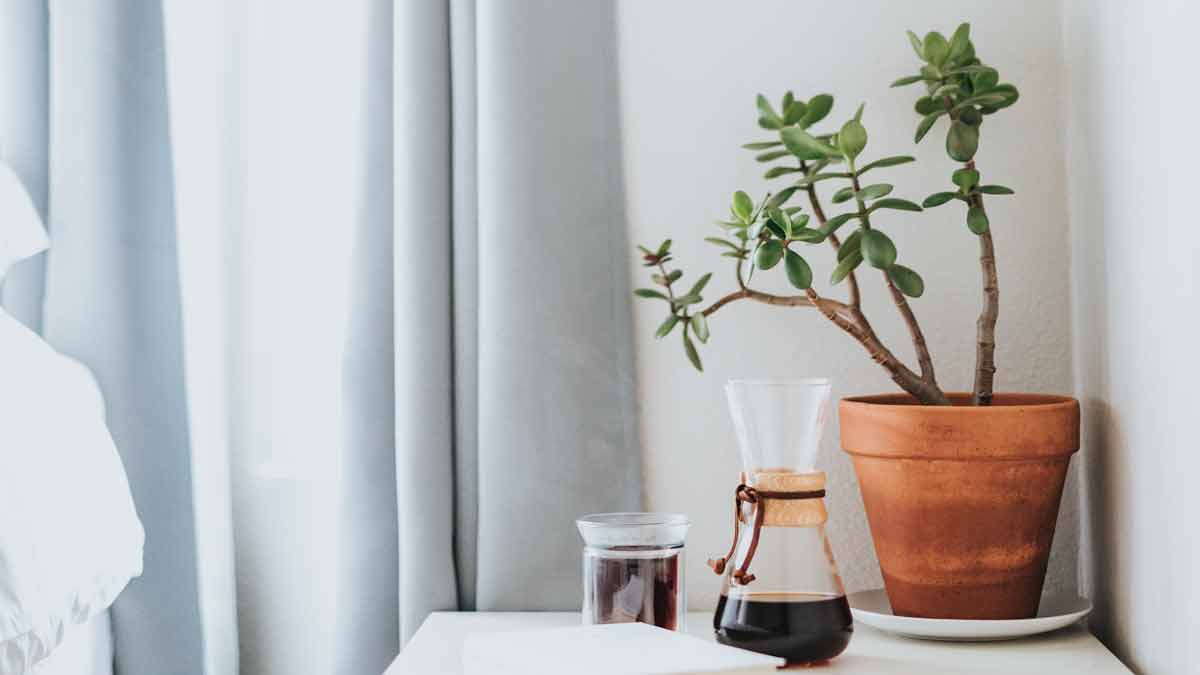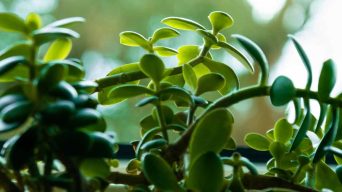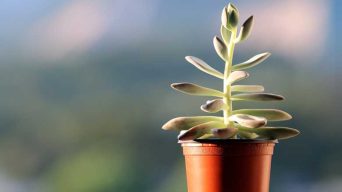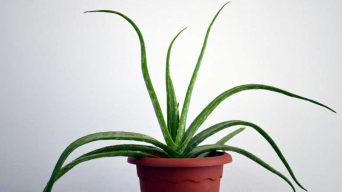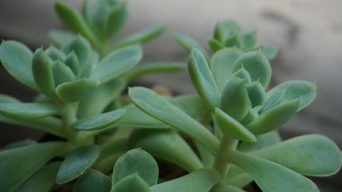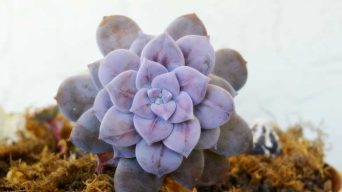A leggy jade plant is typically due to insufficient light, over-fertilization, or lack of pruning. To fix it, move to a brighter spot, prune, stop over-fertilizing, and repot if needed. Regular care helps prevent legginess for this resilient houseplant.
The jade plant, also known as Crassula ovata, is a succulent plant native to Africa and Asia.
It’s a popular houseplant because it’s easy to care for and can live for many years with proper care.
Jade plants can become leggy and unbalanced with age. This usually happens when the plant is not getting enough light. The stems become elongated, and the leaves get smaller as the plant stretches toward the light.
If your jade plant looks a bit leggy, there are a few things you can do to fix it.
Here you will find everything you need to know about how to fix a leggy jade plant.
What Causes a Jade Plant to Become Leggy?
There are a few reasons why your jade plant might become leggy.
The most common reasons are:
Not Enough Light
Jade plants need a lot of light to stay compact and bushy. If your plant is not getting enough light, it will stretch towards the nearest light source.
This usually happens when the plant is kept in a dark room or placed too far from a window.
Jade plants need at least 4 hours of sunlight daily to stay healthy. If your plant is not getting enough light, it will become leggy and unbalanced.
They thrive in bright, indirect light and do not do well in dark or shady areas.
The lack of light causes the stems to become elongated and the leaves to get smaller.
The plant will also start to produce fewer leaves and flowers.
Too Much Fertilizer
Jade plants are slow-growing succulents and don’t need a lot of fertilizer. Too much fertilizer can do more harm than good.
If you fertilize your jade plant too often, the roots will become overloaded with nutrients, and the plant will start to stretch out and become leggy.
The leaves will also start to turn yellow and drop off.
High nitrogen fertilizer will also cause the plant to produce more leaves and stems, which can make the plant leggy.
It’s best to fertilize your jade plant once a month with a succulent fertilizer or half-strength all-purpose fertilizer.
Lack of Pruning
Jade plants must be regularly pruned to maintain a compact and bushy shape. If you don’t prune your plant, it will become leggy and unbalanced.
You should prune your jade plant every few months to encourage new growth and prevent the plant from becoming too leggy.
Although jade plants are slow-growing, they can still become leggy if they’re not pruned regularly.
Pruning will also help the plant to produce more leaves and flowers.
How To Tell If Your Jade Plant Is Leggy
There are a few signs that your jade plant is leggy:
The Stems Are Long and Thin
Jade plants have thick, fleshy stems that are short and stubby. If your jade plant’s stems are long and thin, it’s a sign that it’s leggy.
When the plant is grown in low light conditions, the stems will elongate and stretch towards the nearest light source.
This usually happens when the plant is kept in a dark room or placed too far from a window.
Also, the lack of light causes the stems to become thin and spindly, which makes the plant look leggy.
The Leaves Are Small and Far Apart
Jade plants have large, fleshy leaves that are close together. If your jade plant’s leaves are small and far apart, it’s a sign that it’s leggy.
This usually happens when the plant is not getting enough light. As the plant stretches towards the light, the leaves will become smaller and further apart.
The plant will also produce fewer leaves and flowers.
The Flowers Are Few and Far Between
Jade plants produce small, white flowers that are close together. If your jade plant’s flowers are few and far between, it’s a sign that it’s leggy.
This usually happens when the plant is not getting enough light. As the plant stretches towards the light, the flowers will become smaller and further apart.
The plant will also produce fewer leaves and flowers.
The Leaves Are Drooping
Jade plants have thick, fleshy leaves that are upright. If your jade plant leaves are drooping, it’s a sign that it’s leggy.
This usually happens when the plant is not getting enough light.
The leaves will droop as the plant cannot produce enough energy to keep them upright.
The Plant Is Pale Green or Yellow
Jade plants are usually a deep green color. If your plant is pale green or yellow, it’s a sign that it’s leggy.
This usually happens when the plant is not getting enough light. The light is necessary for the plant to produce chlorophyll, which gives it its green color.
Without enough light, the plant will become pale and yellow.
There Is Little or No New Growth
Jade plants are constantly growing and producing new leaves and stems. If there is little or no new growth, it’s a sign that the plant is leggy.
This usually happens when the plant is not getting enough light or nutrients. The lack of light and nutrients will prevent the plant from producing new growth.
The Plant Looks Weak and Unhealthy
If your jade plant looks weak and unhealthy, it’s a sign that it’s leggy.
This usually happens when the plant is not getting enough light or nutrients.
The lack of light and nutrients will cause the plant to become pale and yellow. The leaves will also droop, and the plant will produce fewer leaves and flowers.
How To Fix a Leggy Jade Plant
There are a few things you can do to fix a leggy jade plant:
Move the Plant to a Bright Location
If your jade plant is leggy, the first thing you should do is move it to a brighter location. The plant needs at least four hours of direct sunlight every day.
If you can’t move the plant outside, put it near a south- or west-facing window. This will give the plant the most light possible.
You can also use artificial lighting to supplement the plant’s light needs. Grow lights are a good option for indoor plants.
Prune the Plant
If your jade plant is leggy, you can prune it to encourage new growth. Start by cutting off the leggy stems.
You can also prune the plant to encourage a denser growth habit. To do this, cut the stems back to where they branch off.
This will encourage the plant to produce new stems and leaves.
Stop Fertilizing the Plant
If you’re fertilizing your jade plant, stop. Too much fertilizer can cause the plant to become leggy.
Only fertilize the plant when it’s actively growing. Use a balanced fertilizer that is low in nitrogen.
Too much nitrogen will encourage the plant to produce more leaves and stems, making it leggy.
Repot the Plant
If your jade plant is leggy, you may need to repot it. This will give the roots more room to grow and encourage new growth.
Use a pot that is slightly larger than the current one. Be sure to use a well-draining potting mix.
Jade plants need to be repotted every two to three years.
How to Prune a Leggy Jade Plant (A Step-By-Step Guide)
If your jade plant is leggy, you can prune it to encourage new growth. Pruning jade plants is easy to do and doesn’t require any special tools.
To prune a leggy jade plant, follow these steps:
- Cut off the leggy stems. These stems are longer than the others and have fewer leaves.
- Cut the stems back to where they branch off. This will encourage the plant to produce new stems and leaves.
- Remove any dead or dying leaves. Dead leaves can harbor diseases that can infect the plant.
- Prune any damaged or diseased leaves. These leaves should be removed to prevent the spread of disease.
- Cut back any long or straggly branches. These branches can be cut back to the desired length.
- Once you’re finished pruning, water the plant deeply, this will help the plant recover from the pruning and encourage new growth.
Pruning jade plants is a great way to encourage new growth and keep the plant looking its best. By following these steps, you can easily prune your leggy jade plant.
How To Prevent a Leggy Jade Plant
There are a few things you can do to prevent your jade plant from becoming leggy:
Give the Plant Enough Light
Jade plants need at least four hours of direct sunlight every day. If you can’t move the plant outside, put it near a south- or west-facing window. This will give the plant the most light possible.
You can also use artificial lighting to supplement the plant’s light needs. Grow lights are a good option for indoor plants.
Turn the Plant Regularly
Jade plants grow toward the light. So, if you don’t turn the plant regularly, it will become leggy as it stretches to reach the light source.
To prevent this, turn the plant a quarter turn every week or so. This will help the plant grow evenly and prevent it from becoming lopsided.
Fertilize the Plant Properly
If you’re fertilizing your jade plant, use a balanced fertilizer low in nitrogen. Too much nitrogen will encourage the plant to produce more leaves and stems, making it leggy.
Only fertilize the plant during the growing season. This will give the plant the nutrients it needs to produce new growth.
Repot the Plant
If your jade plant is growing in a too small pot, it will become rootbound. This will cause the plant to become stressed, leading to leggy growth.
Repot the plant every two or three years or when you see roots coming out of the drainage holes in the bottom of the pot. Use a pot that is slightly larger than the current pot.
Prune the Plant Regularly
Pruning your jade plant will encourage it to produce new growth. This new growth will help fill the plant and make it less leggy.
Prune the plant in the spring before the growing season begins. Use sharp, clean pruning shears to avoid damaging the plant.
Remove any leggy stems from the plant. Cut the stems back to where they branch off from the main stem.
How To Propagate a Leggy Jade Plant
Having a leggy jade plant is an excellent opportunity to propagate the plant. This will give you a new plant that is bushy and full.
To propagate a leggy jade plant, follow these steps:
- Cut a stem from the plant that is at least six inches long. This stem should have at least two leaves.
- Remove the lower leaves from the stem. These leaves will be buried in the soil and will not take root.
- Dip the cut end of the stem in a rooting hormone. This will encourage the plant to produce roots.
- Fill a pot with a well-draining potting mix. Stick the cut end of the stem into the soil.
- Water the plant well and place it in a warm, sunny spot. Keep the soil moist but not soggy.
The plant will produce roots in four to eight weeks. Once the plant has rooted, you can transplant it into a larger pot.
By following these steps, you can quickly propagate your leggy jade plant. This will allow you to create new plants that are fuller and less leggy.
Final Thoughts
Jade plants are beautiful and easy to care for houseplants. They can live for decades with the proper care.
However, even the best cared-for jade plants can become leggy over time.
You can do several things to fix a leggy jade plant, including pruning, repotting, and providing more light.
Pruning is the most effective way to encourage your jade plant to branch out and become fuller. Repotting will help to refresh the soil and give your plant a boost of nutrients.
Providing more light will also help your plant to become fuller and more compact. If you can provide bright, indirect sunlight for your jade plant, it will encourage it to grow more evenly.
With a bit of time and effort, you can have a full, healthy jade plant that is the envy of all your friends.

